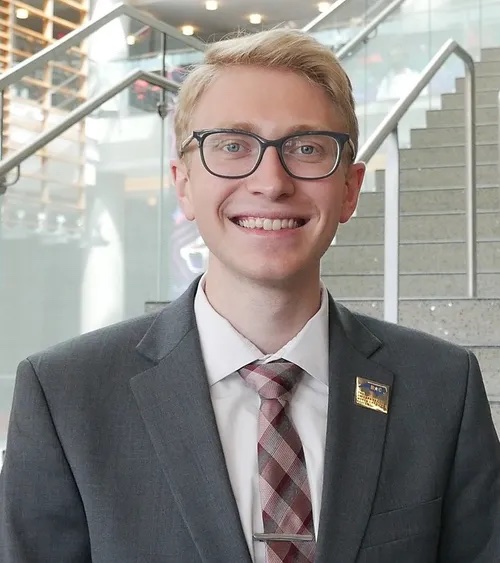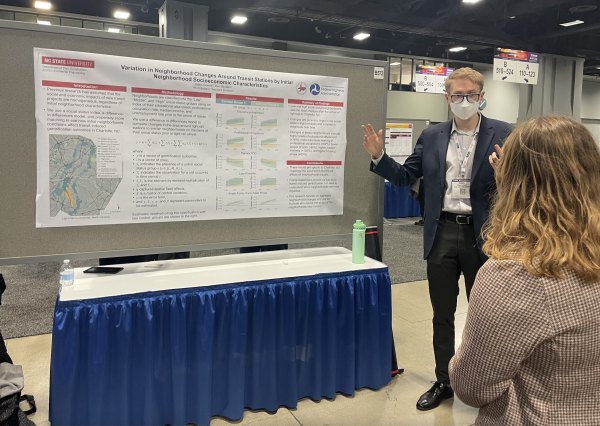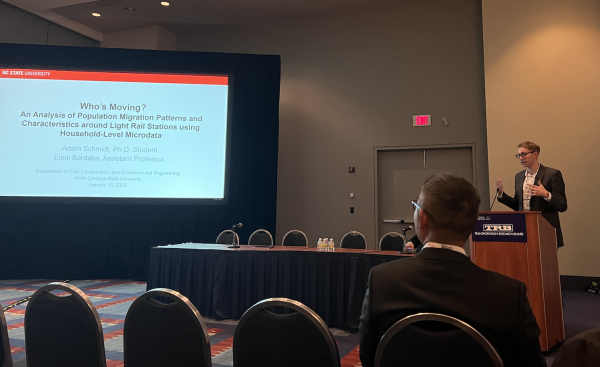
CCEE Ph.D. student Adam Schmidt was selected — for a second time — as a 2022-23 Dwight David Eisenhower Graduate Fellow by the U.S. Department of Transportation (USDOT)’s U.S. Federal Highway Administration. He previously received the award for the 2021-22 academic year. Established as part of the Intermodal Surface Transportation Act of 1991, this program awards fellowships to students pursuing degrees in transportation-related disciplines.
“It felt great to receive the fellowship, and I’m very grateful to USDOT and the Federal Highway Administration for supporting me once again,” Schmidt said. “The Eisenhower Program awards about 100 graduate fellowships each year, and while I saw a few returning names and faces, I think there were only a handful of us that received the fellowship last year and this year. Receiving the fellowship again felt very affirming, since it makes me think the group that selects the Eisenhower Fellows believes my research is aiming to understand important, real-world problems, and that they believe I have the potential to become a leader in the transportation industry that will help solve those problems.”
In addition to helping fund his research at CCEE, the Eisenhower Fellowship funded Schmidt’s participation in the Transportation Research Board (TRB) Annual Meeting in Washington, D.C., in January.
“Going to TRB gave me the opportunity to share ideas with other researchers, talk about research applications with practicing planners and engineers, and meet other Eisenhower Fellows who I hope will one day take on leadership roles in our industry.”
Adam Schmidt, CCEE Ph.D. student

Schmidt, who is advised by Dr. Eleni Bardaka, presented two research projects focused on the light rail train system in Charlotte, North Carolina, at the TRB meeting.
The first project studies the relationship between new light rail transit infrastructure and socioeconomic changes, like gentrification, in nearby neighborhoods.
“Unlike existing research, which assumes all neighborhoods are impacted by transit infrastructure in the same way, the project I’m working on tries to understand the relationship between initial neighborhood characteristics and the changes those neighborhoods see after new transit stations open,” Schmidt said. “We usually expect some neighborhoods, especially low-income neighborhoods, to be more impacted than others, but there hasn’t been much research to test that. The research I presented showed that low-income neighborhoods in Charlotte did see some of the largest changes in neighborhood socioeconomic conditions after the light rail system opened.”

The other project involves studying the movement patterns and characteristics of households in the areas near light rail stations.
“Most of what we know about how neighborhoods change after new transit stations open is based on average changes we observe through U.S.Census data,” Schmidt said. “That makes it difficult to figure out if those neighborhood changes are due to households moving in, moving out, or some combination of both. I’m using a dataset meant for market research to anonymously track households over time, and that allows me to see where the households that move to neighborhoods near transit are coming from, where the households that move out are going, and what the characteristics of all those households are. While results from the first project I presented show that low-income neighborhoods change, results from this project seem to show those changes aren’t necessarily due to the fact that low-income households are getting pushed out of their neighborhoods. Results for this project are in their early-stages, though, and there’s a lot more work left to do!”
